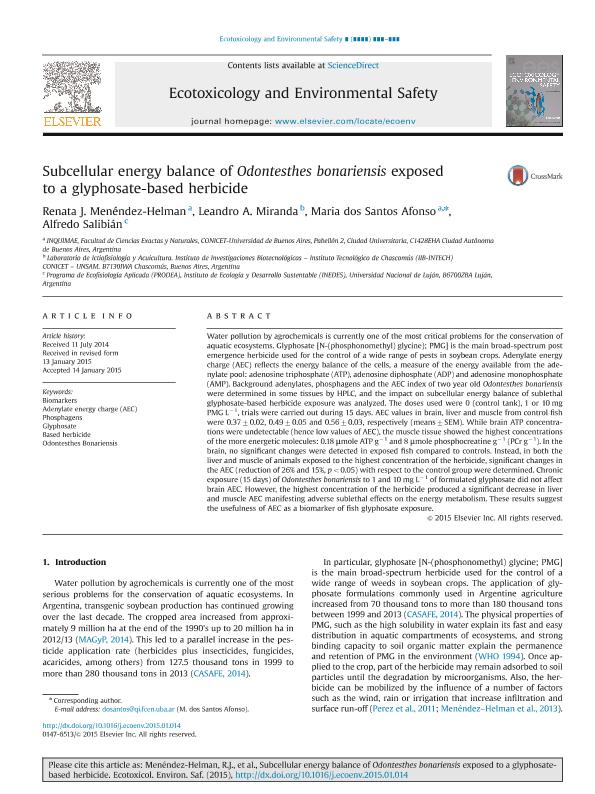Artículo
Subcellular energy balance of Odontesthes bonariensis exposed to a glyphosate-based herbicide
Menendez Helman, Renata Julia ; Miranda, Leandro Andres
; Miranda, Leandro Andres ; Dos Santos Afonso, María; Salibián, Alfredo
; Dos Santos Afonso, María; Salibián, Alfredo
 ; Miranda, Leandro Andres
; Miranda, Leandro Andres ; Dos Santos Afonso, María; Salibián, Alfredo
; Dos Santos Afonso, María; Salibián, Alfredo
Fecha de publicación:
04/2015
Editorial:
Elsevier
Revista:
Ecotoxicology and Environmental Safety
ISSN:
0147-6513
Idioma:
Inglés
Tipo de recurso:
Artículo publicado
Clasificación temática:
Resumen
Water pollution by agrochemicals is currently one of the most critical problems for the conservation of aquatic ecosystems. Glyphosate [N-(phosphonomethyl) glycine); PMG] is the main broad-spectrum post emergence herbicide used for the control of a wide range of pests in soybean crops. Adenylate energy charge (AEC) reflects the energy balance of the cells, a measure of the energy available from the adenylate pool: adenosine triphosphate (ATP), adenosine diphosphate (ADP) and adenosine monophosphate (AMP). Background adenylates, phosphagens and the AEC index of two year old Odontesthes bonariensis were determined in some tissues by HPLC, and the impact on subcellular energy balance of sublethal glyphosate-based herbicide exposure was analyzed. The doses used were 0 (control tank), 1 or 10mg PMGL-1, trials were carried out during 15 days. AEC values in brain, liver and muscle from control fish were 0.37±0.02, 0.49±0.05 and 0.56±0.03, respectively (means±SEM). While brain ATP concentrations were undetectable (hence low values of AEC), the muscle tissue showed the highest concentrations of the more energetic molecules: 0.18μmole ATPg-1 and 8μmole phosphocreatineg-1 (PCrg-1). In the brain, no significant changes were detected in exposed fish compared to controls. Instead, in both the liver and muscle of animals exposed to the highest concentration of the herbicide, significant changes in the AEC (reduction of 26% and 15%, p<0.05) with respect to the control group were determined. Chronic exposure (15 days) of Odontesthes bonariensis to 1 and 10mgL-1 of formulated glyphosate did not affect brain AEC. However, the highest concentration of the herbicide produced a significant decrease in liver and muscle AEC manifesting adverse sublethal effects on the energy metabolism. These results suggest the usefulness of AEC as a biomarker of fish glyphosate exposure.
Archivos asociados
Licencia
Identificadores
Colecciones
Articulos(CCT - LA PLATA)
Articulos de CTRO.CIENTIFICO TECNOL.CONICET - LA PLATA
Articulos de CTRO.CIENTIFICO TECNOL.CONICET - LA PLATA
Articulos(IIB-INTECH)
Articulos de INST.DE INVEST.BIOTECNOLOGICAS - INSTITUTO TECNOLOGICO CHASCOMUS
Articulos de INST.DE INVEST.BIOTECNOLOGICAS - INSTITUTO TECNOLOGICO CHASCOMUS
Articulos(INQUIMAE)
Articulos de INST.D/QUIM FIS D/L MATERIALES MEDIOAMB Y ENERGIA
Articulos de INST.D/QUIM FIS D/L MATERIALES MEDIOAMB Y ENERGIA
Articulos(SEDE CENTRAL)
Articulos de SEDE CENTRAL
Articulos de SEDE CENTRAL
Citación
Menendez Helman, Renata Julia; Miranda, Leandro Andres; Dos Santos Afonso, María; Salibián, Alfredo; Subcellular energy balance of Odontesthes bonariensis exposed to a glyphosate-based herbicide; Elsevier; Ecotoxicology and Environmental Safety; 114; 4-2015; 157-163
Compartir
Altmétricas



